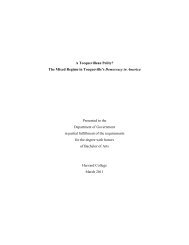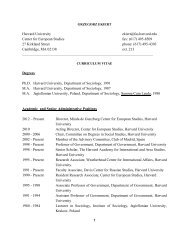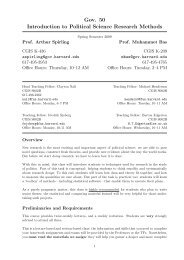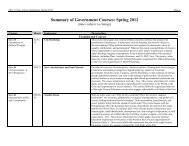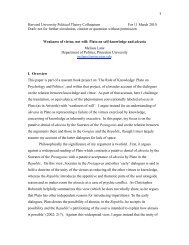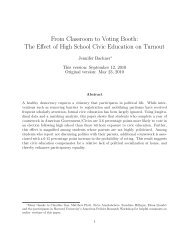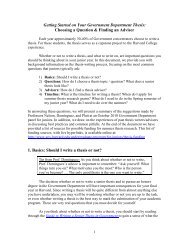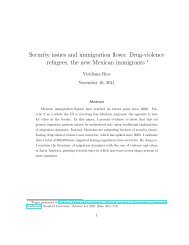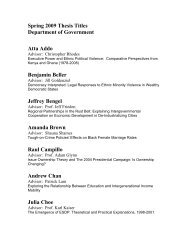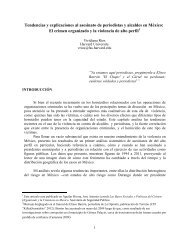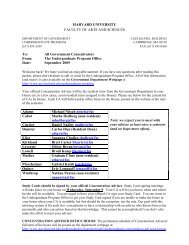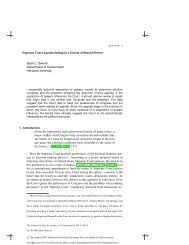Why did Mexico become so violent? - Department of Government ...
Why did Mexico become so violent? - Department of Government ...
Why did Mexico become so violent? - Department of Government ...
You also want an ePaper? Increase the reach of your titles
YUMPU automatically turns print PDFs into web optimized ePapers that Google loves.
Author's per<strong>so</strong>nal copy<br />
Trends Organ Crim (2013) 16:138–155 147<br />
significant variations in the timing and geographic location <strong>of</strong> violence in the areas<br />
where La Familia has operated. Among La Familia states, Michoacán’s violence<br />
remained relatively controlled compared to other states with a strong cartel<br />
presence, with drug-related homicides only increasing 60 % from 2007 to<br />
2010. Michoacán had a clear trend with three distinct patterns: a period <strong>of</strong><br />
steadily low violence until early 2009, a spike during the spring and summer <strong>of</strong><br />
2009, and a high plateau <strong>of</strong> violence ever since then. Drug-related homicides in<br />
Guerrero experienced an upward trend which started in April 2008 and the state<br />
witnessed a quite dramatic spike <strong>of</strong> violence in May 2010. Finally, Guanajuato<br />
only had a period <strong>of</strong> high violence during the summer <strong>of</strong> 2009. <strong>Mexico</strong> State<br />
has not experienced important changes in drug-related violence. Within La<br />
Familia states, about 40 % <strong>of</strong> all drug-related homicides happening from<br />
2006 to 2010 concentrated in just 13 municipalities. Each <strong>of</strong> these had an<br />
average <strong>of</strong> 196 homicides, the top 3 being Acapulco, Guerrero (661 cases),<br />
Morelia, Michoacán (260), and Ecatepec, <strong>Mexico</strong> State (212). The other 17<br />
municipalities, which had between 50 and 100 homicides over the same time<br />
period, accounted for 17 % <strong>of</strong> all violence happening in La Familia’s states.<br />
Fifty-two municipalities had between 20 and 50 homicides (23 % <strong>of</strong> all<br />
violence), and 65 had a complete absence <strong>of</strong> violence.<br />
To analyze battles for turf emerging as a result <strong>of</strong> increased competition, the presence<br />
<strong>of</strong> other trafficking organizations within La Familia’s areas <strong>of</strong> operation are tracked to<br />
approximate the date when a new drug trafficking organization started operating, that is<br />
to say, the date when such territory became competitive. To track the presence <strong>of</strong> rival<br />
cartels, a very particular feature <strong>of</strong> Mexican drug trafficking organizations is taken into<br />
account: their tendency towards communicating using <strong>so</strong>-called “narco-messages.” A<br />
narco-message is a billboard that traffickers leave on the streets to clarify why they<br />
assassinated <strong>so</strong>meone, to intimidate other potential victims, identify themselves or their<br />
victims, communicate with citizens around the area, or give instructions to the investigators<br />
who, traffickers know, will eventually record the messages, among other<br />
rea<strong>so</strong>ns. Narco-messages go all the way from maxims like “you cannot be on good<br />
terms with both God and the Devil,” to messages directed to “the brave, noble, and loyal<br />
people” wishing them “Merry Christmas, ho, ho, ho” or letting them know that “this is<br />
for the good <strong>of</strong> all” (Rios 2012a).<br />
A list <strong>of</strong> about 1,880 narco-messages was collected for this study and all possible<br />
information contained in them was analyzed to ascertain the presence <strong>of</strong> a drug<br />
trafficking organization in an area. Overall, the presence <strong>of</strong> more than 350 gangs<br />
and individual traffickers in <strong>Mexico</strong> could be tracked using narco-messages and<br />
newspaper records (Coscia and Rios 2012). This meant that the activities <strong>of</strong> at least<br />
1 drug trafficking organization operating in 504 out <strong>of</strong> 1070 municipalities with<br />
recorded drug activities could be identified. This information was used to create a<br />
monthly indicator <strong>of</strong> territorial competition at the municipal level which is simply<br />
given by the number <strong>of</strong> drug trafficking organizations simultaneously operating in a<br />
municipality on a given month and/or year. The data provides evidence to support the<br />
argument that, when competition is more intense, drug-related violence spikes. There<br />
are two clear instances in which violence significantly increased in La Familia<br />
territories and both <strong>of</strong> them are related to the entrance <strong>of</strong> Los Zetas, another drugtrafficking<br />
organization in La Familia territories.



